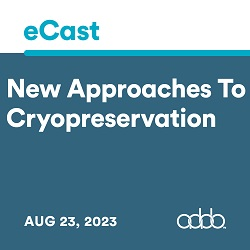

Product Code: 23EL-866-4035
Please note: This is a Single Viewer registration for one participant for the on-demand version of this program. Access instructions for the on-demand version of this program will be provided via email approximately 3-10 business days after the live program has occurred and the on-demand version is available. If registering after the on-demand version is available, immediate access is granted via the AABB Education Platform at https://education.aabb.org.
If you registered for the live program you do not need to register for this on-demand eCast (access to the on-demand eCast was included with the live program registration).
If you are interested in presenting this program to a group, please see the “eCast Registration Form– Group Viewing” form on the program page.
Program Description: Biotherapies are conferring hope in the treatment of incurable rare diseases and hold a promise of curing untreatable conditions in the near future. Cryopreservation has been the main method for preserving biological samples for long term storage. It has allowed us to use samples collected for research and therapies from decades ago to do new research and obtain new cures.
Most systems of cellular cryopreservation use a controlled-rate freezer (CRF), or employ dump freezing methods, which are also known as uncontrolled rate (or passive) freezing methods. The CRF freezing system delivers liquid nitrogen into a closed chamber into which the cell suspension is placed. Careful monitoring of the rate of freezing helps to prevent rapid cellular dehydration and ice-crystal formation. The dump freezing method relies heavily on the variability of source of samples, the process of manufacturing and on the variability in the temperature of the freezers. Both methods have been studied for their advantages and disadvantages. A long-term, practical solution to these difficulties lies in successful cryopreservation that offers secure, stable storage at temperatures below -130°C where metabolic change will not occur.
In this program, the faculty explore the challenges with cryopreservation, the new techniques being utilized for innovative products and for the emerging advances that could improve these methods. The essential elements of the cryopreservation process that have to be taken into consideration for process development, with the science underlying cryopreservation at a more fundamental level such as the method of freezing, the correct methods for validations of products and the acceptable release criteria to support successful Biotherapies will be presented in this program.